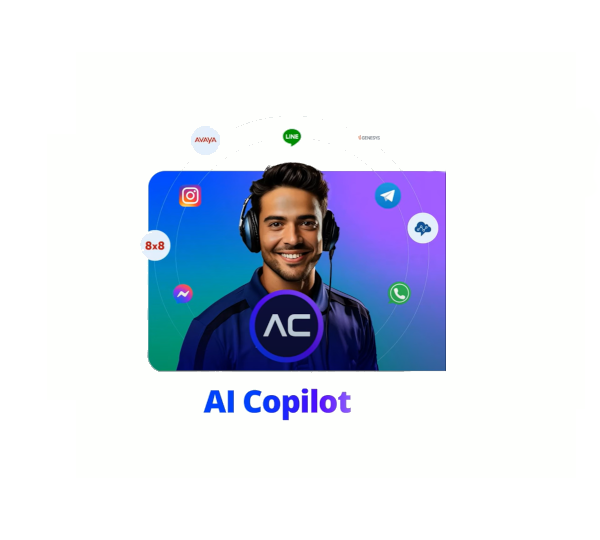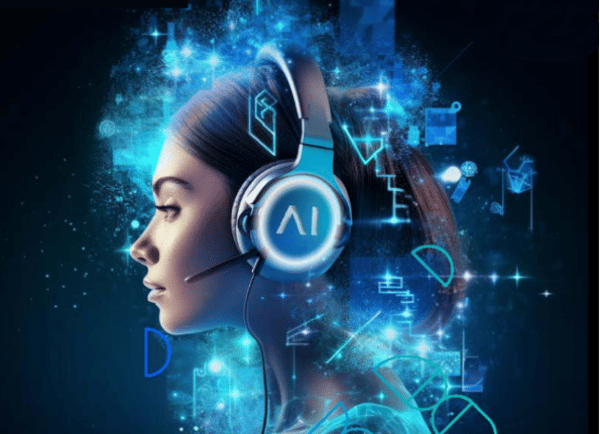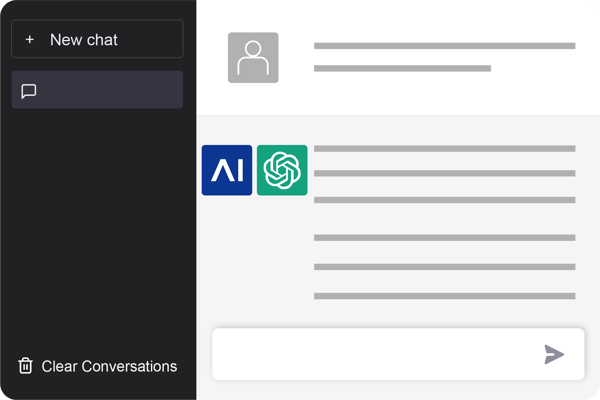AI technology is advancing rapidly, and it's now possible to create conversational virtual agents that can understand and reply to a wide range of queries. Conversational AI is what chatbots wish they could be.
But business owners wonder, how are they different, and which one is the right choice for your organizational model? We'll break down the competition between chatbot vs. Conversational AI to answer those questions.

What is Conversational AI?
Conversational AI is any technology set that users can talk or type to, then receive a response from. Traditional chatbots, smart home assistants, and some types of customer service software are all varieties of conversational AI.
In this context, however, we're using this term to refer specifically to advanced communication software that learns over time to improve interactions and decide when to forward things to a human responder.
The key to conversational AI is its use of natural language understanding (NLU) as a core feature.
What is natural language understanding?
NLU is a scripting process that helps software understand user interactions' intent and context, rather than relying solely on a predetermined list of keywords to respond to automatically.
Consider the following queries:
I canceled my order, and I want a refund.
You canceled my order. When do I get my refund?
While these sentences seem similar at a glance, they refer to different situations and require different responses. A regular chatbot would only consider the keywords "canceled," "order," and "refund," ignoring the actual context here.
In the first scenario, the customer is describing their actions and saying what they want.
A good response from Conversational AI may include something like a verification step: "I see that you canceled Order ### on MM/DD/YYYY; is this the order you want a refund for?"; information; "I checked, and your refund is already on its way; it should arrive within 5-7 business days" or a direction like, "To request a refund, visit this URL."
You can train Conversational AI to provide different responses to customers at various stages of the order process. An AI bot can even respond to complicated orders where only some of the components are eligible for refunds.
In the second scenario above, customers talk about actions your company took and stated what they expect to happen. AI can review orders to see which ones were canceled from the company's side and haven't been refunded yet, then provide information about that scenario.
What are chatbots?
Chatbots are the predecessors to modern Conversational AI and typically follow tightly scripted, keyword-based conversations. This means that they're not useful for conversations that require them to intelligently understand what customers are saying.
That said, there are times when chatbots are helpful tools for companies. Notably, chatbots are suitable for menu-based systems where you can direct customers to give specific responses and that, in turn, will provide pre-written answers or information fetch requests.
If you don't need anything more complex than the text equivalent of a user interface, chatbots are a simple and affordable choice. However, for companies with customer service teams that need to address complex customer complaints, conversational AI isn't just better. In effect, it's constantly improving and widening the gap between the two systems.
Chatbots vs. Conversational AI: Primary features
Conversational AI and chatbots focus on different features. Here are the primary ones that you should know about.
Conversational AI features:
Major features for Conversational AI include:
- Training systems: Supervised and semi-supervised learning solutions allow your customer service agents to review NLU results and provide feedback. Over time, this shapes the AI to understand and respond to your company's unique preferences.
- User-friendly interfaces: Our AI uses a modern, graphical interface, so people don't have to know coding to understand or update the system.
- Extensions: Extensions are plug-and-play conversational modules that can provide instant support for everyday needs without shaping the AI yourself. Check out the following video on what you can expect from combining a Conversational AI platform with robotic process automation (RPA) for faster customer service.
- Automated testing: Extensive, automated regression testing helps ensure that you're still meeting business objectives after changing your AI.
- Multi-language compatibility: Conversational AI systems can work simultaneously in different languages while sharing the same overall logic and integrations.
These are only some of the many features that conversational AI can offer businesses. Naturally, different companies have different needs from their AI, which is where the value of its flexibility comes into play. For example, some companies don't need to chat with customers in different languages, so it's easy to disable that feature.
Chatbot features:
The primary features of most chatbots include:
- Keyword Focus: Most chatbots don't understand sentences. Instead, they look for specific words that customers type, then provide an automated response to those words.
- Quick Deploy Times: Chatbots are relatively easy to deploy within your system, which is useful if you need to get something up quickly. Conversational AI is fundamentally more powerful and capable than chatbots, but it does take time to use machine learning to shape an AI's responses.
- Customer Intents: Most chatbots can handle anywhere from 100-200 customer intents well. In this context, a customer intent is something that a customer is trying to communicate to the chatbot, usually involving a specific combination of keywords.
Chatbots vs. Conversational AI: What are the business values?
Conversational AI offers numerous types of value to different businesses, ranging from personalizing data to extensive customization for users who can invest time in training the AI. With that said, conversational AI offers three points of value that stand out from all the others.
Conversational AI: Better customer experiences
Conversational AI provides rapid, appropriate responses to customers to help them get what they want with minimal fuss. This offers a significantly better experience than basic chatbots.
Conversational AI: Shorter waiting times
Conversational AI can handle immense loads from customers, which means they can functionally automate high-volume interactions and standard processes. This means less time spent on hold, faster resolution for problems, and even the ability to intelligently gather and display information if things finally go through to customer service personnel.
Conversational AI: Better human support
Finally, conversational AI can enable superior customer service across your company. This means more cases resolved per hour, a more consistent flow of information, and even less stress among employees because they don't have to spend as much time focusing on the same routine tasks.
With a lighter workload, human agents can spend more time with each customer, provide more personalized responses, and loop back into the better customer experience.
Chatbots: Ease of implementation
Chatbots are fundamentally more straightforward to implement than conversational AI, often to the point where a single user can do a guided process to install and customize the system when given the time to focus on it.
Chatbots are essentially simple query-and-response systems. If you know what people will ask or can tell them how to respond, it's easy to provide rapid, basic responses.
Most companies use chatbots for customer service, but you can also use them for other parts of your business. For example, you can use chatbots to request supplies for specific individuals or teams or implement them as shortcut systems to call up specific, relevant information.
Which is better for your company?
In the chatbot vs. Conversational AI debate, Conversational AI is almost always the better choice for your company. It takes time to set up and teach the system, but even that's being reduced by extensions that can handle everyday tasks and queries. Once a Conversational AI is set up, it's fundamentally better at completing most jobs.
.gif?width=700&name=flow_editor_recording_FULL%20(1).gif)
That said, the real secret to success with chatbots and Conversational AI is deploying them intelligently. With Cognigy.AI, you can leverage the power of an end-to-end Conversational AI platform and build advanced virtual agents for chat and voice channels and deploy them within days.
Schedule a demo to learn more about what Cognigy.AI can do for your company, or sign up for our free trial to try it for yourself!

.png?width=60&height=60&name=AI%20Copilot%20logo%20(mega%20menu).png)




.png?width=600&height=600&name=Knowledge%20AI%20Feature%20image%20(2).png)













